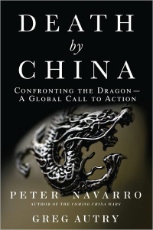 Excerpt
from Death By China: Confronting the Dragon - A Global Call to Action
Excerpt
from Death By China: Confronting the Dragon - A Global Call to Action
by Peter Navarro and Greg Autry
Death By Currency Manipulation: Crouching
Tiger, Nuking Dragon
American workers can compete
dollar for dollar against Chinese workers. They just can't
compete dollars against manipulated yuans.
-- Eric Lotke, Campaign for America's Future
If money is the root of all evil, then China's manipulation of
its currency, the yuan, is the tap root of everything wrong with
the U.S. -China trade relationship. For more than a decade,
chronic U.S. trade deficits with China have dramatically slowed
America's economic growth rate and spiked our unemployment rate.
Yet it would be impossible for China to keep sucking the
lifeblood out of the American economy without its fangs of
currency manipulation.
China manipulates its currency by artificially "pegging" the
Chinese yuan to the U.S. dollar at a grossly undervalued fixed
exchange rate. To understand why this debilitates the American
economy, it is critical to understand that any nation's economy
is driven by only four factors: consumption, business
investment, government spending, and "net exports."
This last growth driver -- net exports -- is the most important
for our discussion of Chinese currency manipulation because it
measures the difference between how much we export to the world
minus how much we import. And here is a critical observation
that underscores the essential role that net exports
play in our economy:
When America runs a chronic trade
deficit with China, this shaves critical points off our economic
growth rate. This slower growth rate, in turn, thereby reduces
the number of jobs America creates.
Of course, as the American economy suffers from slow growth and high unemployment, China enjoys just the opposite effect. The Dragon booms while America goes bust.
Another Day Older, Deeper in Debt, and Slower in Growth
So just how big is our trade deficit with China? Just how many
jobs has our "Chinese import dependence" cost us? And why is
currency manipulation a principal reason the United States is
unable to significantly reduce its trade deficit? Only by
knowing the answers to these questions can we escape from
China's currency manipulation trap. Let's start then with the
size of the U.S. trade deficit.
In terms of absolute size, America imports almost $1 billion a day more than it exports from China every business day of the year. That's not a typo; it's billion not million.
In terms of relative size, the U.S. -China trade
deficit is equally astonishing. China accounts for almost half
of our annual trade deficit in goods and fully 75% when
petroleum imports are removed from the calculation. Here is one
logical policy inference from these statistics:
If America wants to reduce its overall trade deficit to increase its growth rate and create more jobs, the best place to start is with currency reform with China!
As for the actual impact our Chinese import dependence has had
on America's growth and unemployment rates, this, too, is
mind-boggling. Over the past decade, our trade deficit with
China has typically shaved off close to half a point of GDP
growth a year. While that might not seem like a large sum, it
translates into a cumulative impact of millions of jobs that the
American economy failed to create. If we had those jobs right
now plus the millions more manufacturing jobs that
China's unfair trade practices have destroyed outright, we
wouldn't be seeing unemployment lines wrapping around government
buildings, fields of padlocked houses under foreclosure, and
America's empty factories pushing up weeds. Instead, we'd be on
the sunny side of Easy Street.
As a side note, these stunning statistics always remind us of
the story about Willie Sutton, the famous bank robber. When they
asked Sutton why he robbed banks, he famously replied, "Because
that's where the money is." Just as banks are where the money
is, China's currency manipulation is where our best hope of
reducing our trade deficit -- and reclaiming robust economic
growth -- lies.
Hard Times for America from China's Hard Dollar Peg
So, just how does China manipulate its currency? It does so by
effectively "hardpegging" its yuan to the dollar at a grossly
undervalued fixed exchange rate: around six yuan to the dollar.
This ultra-cheap yuan, in turn, provides a lucrative subsidy for
Chinese exporters while levying a hefty tax on U.S. exports to
China. The result of this currency manipulation, working in
league with the other Chinese unfair trade practices we have
discussed, has been the chronic U.S. trade deficits we have just
weighed and measured.
Now here's the key currency manipulation point: America's trade
imbalance with China could never persist in a world of free
trade where China allowed its currency to float freely alongside
other floating currencies around the world like the euro,
Japanese yen, Swiss Franc, Brazilian real, Indian rupee, and
U.S. dollar.
In a world of free trade characterized by completely floating
exchange rates, the U.S. -China trade imbalance could never
persist because as the U.S. trade deficit rose, the dollar would
fall relative to the yuan. As the dollar fell, U.S. exports to
China would rise, Chinese imports would fall, and trade would
come back into balance. However, by pegging the yuan to the
dollar, a mercantilist China subverts this free trade adjustment
process -- even as it undermines a global free trade framework
based on the promise of mutual gain.
The above is an excerpt from the book Death by China: Confronting the Dragon -- A Global Call to Action by Peter Navarro and Greg Autry. The above excerpt is a digitally scanned reproduction of text from print. Although this excerpt has been proofread, occasional errors may appear due to the scanning process. Please refer to the finished book for accuracy.
Copyright © 2011 Peter Navarro and Greg Autry, authors of Death by China: Confronting the Dragon -- A Global Call to Action
